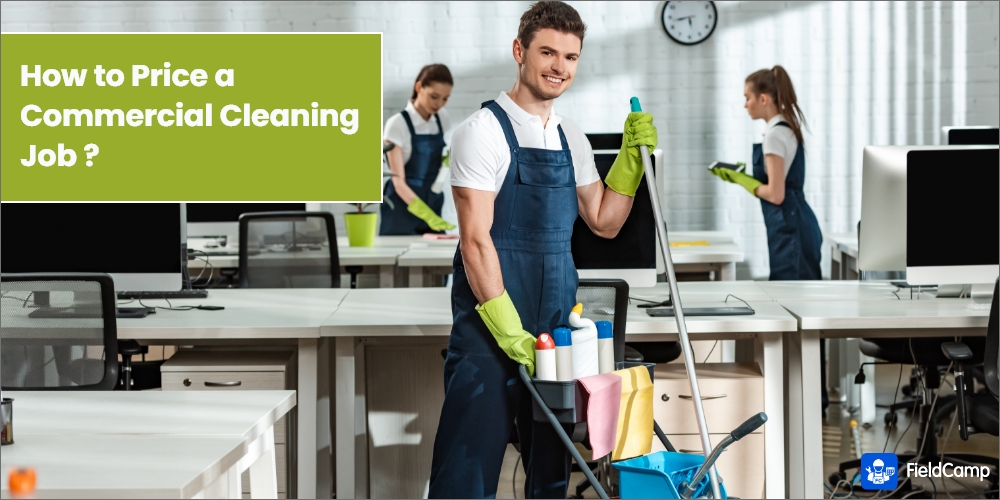
Pricing a commercial cleaning job can be challenging. You need a balance of fair pricing and profitability.
Commercial cleaning involves more than just setting a price. It requires understanding the scope of work, estimating the time, and considering costs. To price jobs accurately, you must evaluate several factors. These include the size of the space, type of cleaning required, and frequency of service.
Knowing how to price a commercial cleaning job effectively ensures you stay competitive and profitable. This guide will walk you through the steps to set the right price, helping you win more contracts without underselling your services. Let’s dive into the key aspects that influence pricing in commercial cleaning.
Assessing The Scope Of Work
Assessing the scope of work is crucial for pricing a commercial cleaning job. This step helps determine the time, effort, and resources needed. Accurately assessing the scope ensures a fair price for both you and the client. Here are key aspects to consider when assessing the scope of work:
Initial Walkthrough
Start with an initial walkthrough of the property. This helps you understand the layout and size of the space. Take notes on each area that requires cleaning. Pay attention to high-traffic zones and special areas.
During the walkthrough, check the condition of the spaces. Are there stains or heavy dirt build-up? This will impact the time and materials needed. Note any potential challenges or obstacles. For example, high ceilings or delicate surfaces.
Client Requirements
Discuss the client’s specific cleaning needs and expectations. Ask about the frequency of cleaning. Do they need daily, weekly, or monthly services? Understand their priorities. Are there areas that need more attention?
Also, inquire about preferred cleaning products. Some clients may want eco-friendly options. Others might have allergies or sensitivities. Knowing these details helps in providing a tailored service. Clarifying client requirements ensures satisfaction and helps in accurate pricing.

Credit: centaurmachines.com
Calculating Labor Costs
Calculating labor costs for a commercial cleaning job is crucial. It helps you ensure profitability. Labor costs include employee wages and time estimates. These factors determine your overall pricing strategy. Let’s break down each component.
Employee Wages
Employee wages form a significant part of labor costs. First, determine the hourly wage of each employee. Consider local wage laws and industry standards. Don’t forget taxes, benefits, and insurance. These can add to the wage costs. Include these in your calculations to get an accurate estimate.
Time Estimates
Time estimates help in calculating labor hours. Start by assessing the size of the cleaning area. Note the type of tasks required. Different tasks take different amounts of time. For example, vacuuming a carpet takes less time than scrubbing floors. Estimate the time for each task. Combine them for the total labor hours.
Consider the number of employees. More employees can complete tasks faster. This impacts the total hours needed. Using realistic time estimates ensures accurate labor cost calculations. It helps avoid underpricing or overpricing your services.
Estimating Supply Expenses
Estimating supply expenses is a crucial step in pricing a commercial cleaning job. It helps determine the overall cost of the project. Knowing how much you will spend on supplies ensures you can price your services accurately. This section breaks down the main components of supply expenses.
Cleaning Products
Cleaning products are essential for any commercial cleaning job. They include detergents, disinfectants, glass cleaners, and floor cleaners. Choose high-quality products to ensure effective cleaning. Buying in bulk can save money. Make a list of all necessary cleaning products and their costs. This helps to keep track of expenses.
Equipment Costs
Equipment costs can vary depending on the job size and requirements. Common equipment includes vacuums, mops, and floor buffers. Investing in durable, reliable equipment reduces long-term costs. Consider renting equipment for one-time jobs to save money. Calculate the cost of buying or renting equipment and add it to your estimate.
Incorporating Overhead Costs
Understanding overhead costs is crucial when pricing a commercial cleaning job. Overhead costs include expenses not directly tied to the cleaning service but are essential for the business. These costs can impact your pricing strategy and profitability. Let’s look at some key components of overhead costs.
Administrative Expenses
Administrative expenses cover various non-labor costs. These include office supplies, utilities, and software subscriptions. These are vital for running your business smoothly.
Consider these common administrative expenses:
- Office Supplies: Paper, pens, and printer ink.
- Utilities: Electricity, water, and internet.
- Software: Accounting and scheduling tools.
Track these expenses carefully. Include them in your pricing to avoid undercharging.
Insurance And Licenses
Insurance and licenses are mandatory for a cleaning business. They protect you and your clients.
Here are some types of insurance you might need:
- General Liability Insurance: Covers accidents and property damage.
- Worker’s Compensation Insurance: Protects your employees if they get injured.
- Bonding: Ensures clients against theft by your employees.
Licenses depend on your location. Check local regulations to determine what you need.
Insurance and licenses can be costly. Always include them in your overhead costs.
Setting Profit Margins
Setting profit margins is crucial in pricing a commercial cleaning job. It ensures your business remains profitable while staying competitive. Understanding how to set the right profit margins can make a difference in your success.
Competitive Analysis
First, research your competitors. Check their pricing for similar services. Note the services they include in their packages. This helps you understand the market rates. Knowing your competitors’ rates gives you a benchmark.
Consider the quality of their work and customer reviews. This insight helps you position your services better. If your services are superior, you can charge a premium. If you offer similar quality, stay within the market rates.
Desired Profit
Decide on your desired profit margin. Calculate your costs first. These include labor, supplies, equipment, and overheads. Add a percentage to these costs to determine your profit margin. This percentage is your desired profit.
Ensure your pricing covers all costs and leaves room for profit. A standard profit margin in the cleaning industry is between 10% to 30%. Adjust this based on your market research and business goals.
Remember, setting the right profit margin ensures sustainability. It keeps your business thriving in a competitive market.

Credit: www.fieldcamp.com
Creating A Detailed Quote
Creating a detailed quote is essential in pricing a commercial cleaning job. It ensures transparency and builds trust with your clients. A clear, well-structured quote helps in avoiding misunderstandings. Let’s dive into the components of crafting a detailed quote.
Itemized Breakdown
An itemized breakdown is crucial for a comprehensive quote. It provides clarity on what services are included. Here is an example:
| Service | Description | Cost |
|---|---|---|
| General Cleaning | Dusting, vacuuming, and mopping floors | $100 |
| Window Cleaning | Cleaning interior and exterior windows | $50 |
| Restroom Sanitation | Cleaning and sanitizing restrooms | $30 |
Breaking down the services helps your client see the value in each task. It also allows for easy adjustments if the client needs to modify the scope of work.
Presentation Format
The presentation format of your quote can make a big difference. A professional format conveys credibility and seriousness. Here are some tips:
- Use headings and subheadings: They make the document easy to navigate.
- Include your company logo: It adds a professional touch.
- Be clear and concise: Avoid jargon and keep sentences short.
- Use bullet points: They help in listing services and details clearly.
Here is a simple structure for your quote:
- Company Information: Name, address, contact details.
- Client Information: Name, address, contact details.
- Service Details: Itemized breakdown of services.
- Total Cost: Sum of all services.
- Terms and Conditions: Payment terms, service terms, etc.
Following these guidelines will help you create a clear and professional quote. This will not only impress your clients but also increase your chances of securing the job.
Adjusting For Market Conditions
Pricing a commercial cleaning job can be complex. One key factor is adjusting for market conditions. This ensures your pricing is competitive and profitable. Let’s dive into two important aspects: local competition and economic factors.
Local Competition
Understanding your local competition is crucial. Start by researching your competitors. Note their pricing strategies, services offered, and customer reviews. This will help you position your services effectively.
Create a table to compare key aspects:
| Competitor | Price Range | Services Offered | Customer Reviews |
|---|---|---|---|
| Company A | $50 – $100 | General Cleaning | 4.5/5 |
| Company B | $60 – $110 | Deep Cleaning | 4.7/5 |
Use this information to find your niche. Maybe you can offer unique services or better pricing. Always remember, quality service can justify higher prices.
Economic Factors
Economic factors also play a role. Consider the current state of the economy. Is it growing or declining? This affects how much clients are willing to spend on cleaning services.
Here are a few factors to consider:
- Inflation rates
- Local employment rates
- Cost of supplies and equipment
Analyze these factors regularly. Adjust your pricing to reflect changes. For example, if inflation is high, increase your rates to cover higher costs.
Being aware of the economic environment helps you stay competitive. It ensures your business remains profitable in all conditions.
Negotiating With Clients
Negotiating with clients is crucial in pricing commercial cleaning jobs. Effective negotiation ensures both parties are satisfied. It can help establish long-term business relationships. Here’s how to navigate the negotiation process successfully.
Understanding Client Budget
Before discussing prices, understand your client’s budget. Ask direct questions about their financial limits. This helps you tailor your service to their needs. It also shows you respect their financial constraints. Knowing their budget can prevent misunderstandings later.
Offering Flexible Options
Offer flexible pricing options to your clients. Different packages can cater to various budgets. For instance, provide basic, standard, and premium cleaning packages. This allows clients to choose what fits them best. Flexibility can make your offer more appealing. It shows you are willing to work with their financial situation.
Frequently Asked Questions
What Factors Affect Commercial Cleaning Job Pricing?
Several factors impact pricing, including the size of the area, type of cleaning, frequency, and special requests.
How Do I Estimate Cleaning Time?
Estimate cleaning time by considering the area size, type of surfaces, and specific cleaning tasks required.
What Should A Commercial Cleaning Quote Include?
A comprehensive quote should include labor costs, materials, equipment, and any additional services requested by the client.
How Often Should Commercial Cleaning Be Done?
The frequency depends on the business type, foot traffic, and cleanliness standards required by the client.
Conclusion
Pricing a commercial cleaning job involves several factors. Consider the size of the area. Analyze the time needed. Assess the required supplies and equipment. Don’t forget labor costs. Research your competitors’ rates too. Transparent pricing builds trust with clients. Accurate quotes help avoid misunderstandings.
Keep refining your pricing strategy. This will ensure fair and competitive rates. Happy cleaning!



